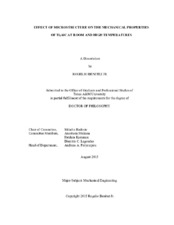| dc.contributor.advisor | Radovic, Miladin | |
| dc.creator | Benitez, Rogelio | |
| dc.date.accessioned | 2015-10-29T19:59:51Z | |
| dc.date.available | 2017-08-01T05:37:28Z | |
| dc.date.created | 2015-08 | |
| dc.date.issued | 2015-07-27 | |
| dc.date.submitted | August 2015 | |
| dc.identifier.uri | https://hdl.handle.net/1969.1/155743 | |
| dc.description.abstract | This study reports on the mechanical properties of Ti2AlC systematically designed with various grain sizes and TiAlx impurity contents at room and elevated temperatures. Room temperature cyclic compressive testing of Ti2AlC of the several microstructures was carried out in combination with resonant ultrasound spectroscopy (RUS) tests and post mortem electron backscatter diffraction (EBSD). Results show that the complex mechanical response of Ti2AlC at room temperature can be divided in four stress regions with distinct underlying mechanisms: (a) Region I linear elastic behavior; (b) Region II in which stress strain hysteric behavior is observed due to reversible dislocation flow in the soft grains; (c) Region III in which accumulation of dislocation walls (DWs) result in cyclic hardening and lager hysteretic loops; (d) Region IV in which microcracking contributes additionally to the before mentioned deformation mechanisms. The transition stresses between regions were found to be strongly dependent on grain size, with coarse grain structures having lower transition stresses than fine grain size and with negligible effects of TiAlx on the transition stresses. In addition, EBSD analysis reveals that the microstructure evolves during loading through the formation of low angle grain boundaries that give rise to the observed strain hardening effects. Room temperature quasi-static tests show that the compressive strength follows a Hall-Petch relationship with the grain length, and not the thickness; an observation supported by the fact that only basal plane dislocations have been previously observed in MAX phases. The fine grain structures fabricated in this study exhibit the highest strength reported to date Ti2AlC. High temperature quasi-static compression testing shows that the compressive strength of the fine grain structures degrades more than the coarse grain structure, regardless of the presence of TiAlx intermetallic. Postmortem EBSD analysis indicate texturing of individual grains for easy slip, more so in fine grain structures. This texturing contributes to the softening observed above the brittle to plastic transition temperature. Microvoid formation and grain refinement are also observed for both fine and coarse structures, with refinement in coarse grains occurring within the grains. | en |
| dc.format.mimetype | application/pdf | |
| dc.language.iso | en | |
| dc.subject | ternary carbides | en |
| dc.subject | kinking | en |
| dc.subject | plastic anisotropy | en |
| dc.subject | Ti2AlC | en |
| dc.subject | MAX phase | en |
| dc.subject | BPTT | en |
| dc.title | Effect of Microstructure on the Mechanical Properties of Ti2AlC at Room and High Temperatures | en |
| dc.type | Thesis | en |
| thesis.degree.department | Mechanical Engineering | en |
| thesis.degree.discipline | Mechanical Engineering | en |
| thesis.degree.grantor | Texas A & M University | en |
| thesis.degree.name | Doctor of Philosophy | en |
| thesis.degree.level | Doctoral | en |
| dc.contributor.committeeMember | Muliana, Anastasia | |
| dc.contributor.committeeMember | Karaman, Ibrahim | |
| dc.contributor.committeeMember | Lagoudas, Dimitris C | |
| dc.type.material | text | en |
| dc.date.updated | 2015-10-29T19:59:51Z | |
| local.embargo.terms | 2017-08-01 | |
| local.etdauthor.orcid | 0000-0003-1269-5105 | |


